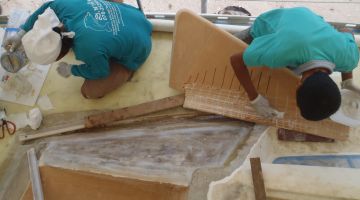
Houa & Max smearing epoxy mud before sticking foam down
29 Rebuild Engines
 Houa & Max smearing epoxy mud before sticking foam down |
Summary: During week 29 of our Thai Refit, the port‑side extension finally got glassed in, but then Baw left the team. Three strips of glass were laid under the deck, at the hull‑deck joint line, to reinforce a cut that was made in the deck back in November. Hem rebuilt both engines and ran each of them, but port still needs more work so he took the head off to work on it. Hem also gave Jon the rebuilt port lower gear‑cluster so Jon installed it and refilled the leg with oil. Houa finished the rail he's been making to go around the battery area and epoxied it in. Max trimmed and epoxied down several complicated sheets of foam, and started working on a cute little hatch for our new compartment. Starboard fo'c's'l was sanded and prepped for gelcoating, but port fo'c's'l has some rotten wood that needs to be replaced. The area behind the cockpit seat finally got foamed, and 11 areas where bolts go through were de‑cored and filled with glass strips. Our boom, forebeam, rudders, and anchor platform were taken to Luck Engineering for welding work, and Luck sent a stainless steel guy to start our hand‑rails (2 each side), and swim ladders. Two joint‑lines on the targa bar were opened up, filled with epoxy mud, and glassed over.
BTW, some folks may not be familiar with Ocelot's layout. Amanda's picture below is also on our Layout Page, which has better explanations, but it's included here for convenience. Hmmm... Guess we're going to have to change this drawing to reflect some of our modifications...
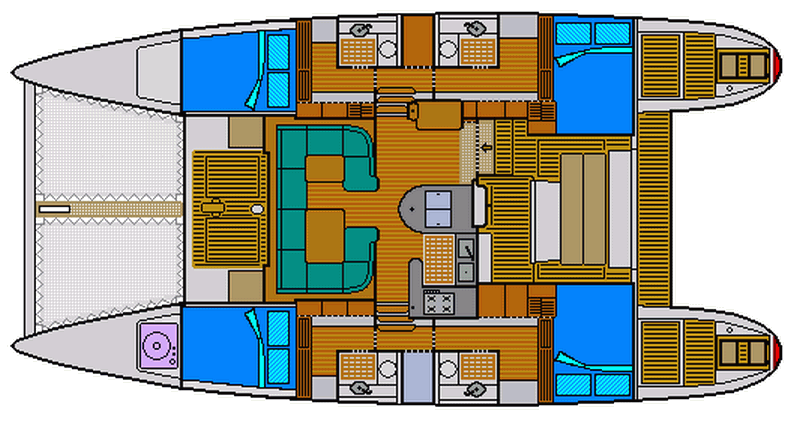
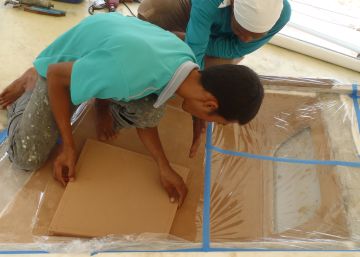 Max & Houa checking the fit on Max's cute little hatch |
Monday, May 7:
No rain today! At least, not after a brief morning shower. So we could have got a lot
done, except that the guys ran out of both foam and epoxy. Today was actually a holiday for
much of Thailand but we should be able to get more tomorrow.
The main work accomplished was by the guys down below. They managed to finish reinforcing
the decks where they'd been cut (in November). The fiberglass strips they epoxied up look like
they should do the job nicely. So now the insides of both hulls are covered in vinyl plastic
with epoxy splatters.![]() But that should get cleaned up pretty quickly.
But that should get cleaned up pretty quickly.
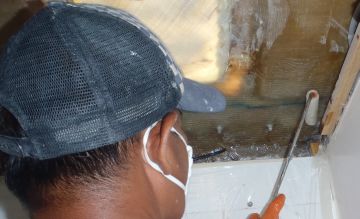 Pla laying reinforcing glass under the deck in port fwd head |
Our mechanic, Hem, and his assistant were communing with the starboard engine all day. A lot of what they did was to empty the starboard fuel tank. The top 20 liters or so were OK, but below that was pretty grungy. This is surprising to us as we've never really had much trouble with our fuel, and we always put a biocide in our tanks, especially if we're not going anywhere for a while. But much of that fuel was purchased on our way back from India in Little Andaman Island from a funky "station" that sold diesel from 55 gallon (200 liter) (rusty) steel drums.
The good news is that Hem feels he's ready to test that starboard engine. We'll need to hook up some cooling water and unwrap the instruments, but it's nice to know he feels he's finished with that engine.
Max was back at work today after being off for the last few days of last week, taking his wife in for prenatal checkups. He epoxied down the complicated sheet of glassed foam that he'd been working on all last week. The sheet has to bend in 2 directions, so Max glassed one side (to make it stronger) and then cut grooves in the underside so he could bend it. Even so, he had to hold it in place by screwing boards into neighboring (good) fiberglass.
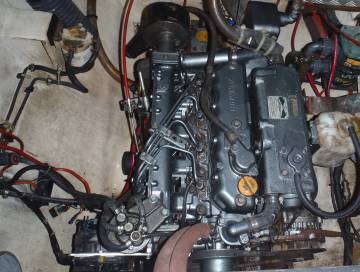 Nice new clean starboard engine |
Never one to be idle for long, Max then started working on a cute little hatch for our new starboard compartment. He cut a sheet of foam down to size and then epoxied on some stiffening strips around the outside. We're not quite sure how it's all going to work but these sorts of things are always fun to watch.
Houa was working most of the day on Katani 2, but managed to glass the bottom of the rail he's making for the battery area.
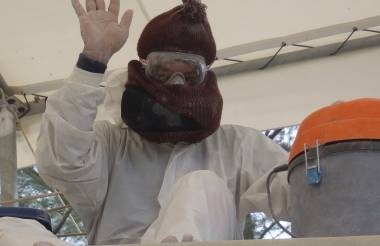 All covered up for sanding inside the fo'c's'ls |
Tuesday, May 8:
Another day with no rain, and a full crowd of workers!
The big news today was that Hem, our mechanic, finished putting together both of our engines, and then he started both of them! He had to jump‑start the engines as the control panels (with the keys) are all wrapped up in plastic to protect them and would have taken about an hour to get to. The bad news is that, although starboard engine started easily and purred like a kitten, port engine was very rough, as if it was only running on 3 cylinders. This is somewhat surprising, as Hem did a lot more work on our starboard engine, removing the head and servicing the injector pump and cleaning the whole fuel system. Hem wanted permission to take the head off port engine to see what's the matter, but that would mean that we'd have to pay for it. We told him that port engine was running fine when we were hauled out. Everyone's scratching their heads a bit, but we're hopeful that Hem will think of something. He's reputed to be an excellent mechanic, and we've been told repeatedly that we don't have to worry if he's looking after our engines.
Before he started port engine, Hem gave Jon the gear‑cluster from the bottom of the port sail‑drive. He'd replaced not only the 2 shaft‑seals, but also the main bearing. Jon quickly greased it up, slid it into the sail‑drive, and then filled the sail‑drive with 90W hypoid oil so Hem could continue his testing.
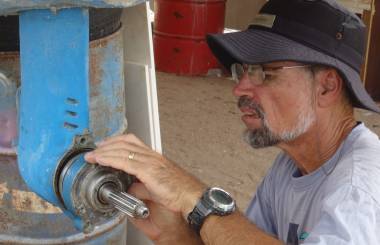 Jon inserting the bottom gear-cluster into the sail-drive |
Baw was back, having worked out his issues with Golf, and working on the wall to our port‑side extension. The outside of this wall doesn't follow the curve of the hull very well, so it will have to be filled in quite extensively. Not sure yet how that's going to happen. After sanding things back a bit to get them ready for glassing, Baw and Lek filled the cutouts for the hand‑rails with small circles of fiberglass, building them up to the surface (they're about 1" or 25mm deep).
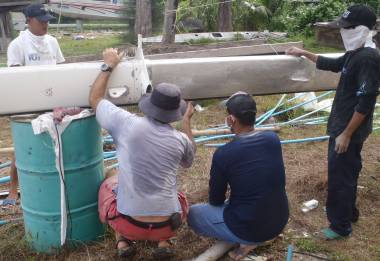 Jon talking to the guys stripping the paint off the mast |
Jon and Golf made a trip into town to see the metal‑workers (Luck Engineering). We talked more about what we want done to the spars that they'd brought on their truck last week, making sure that everyone understood everything. We still haven't settled on a bearing material for the rudders. Luck can get Delrin (which they call Pom) and that would probably be OK, but we've recently heard that Vesconite is supposed to be the ideal material. Vesconite is a plastic made in South Africa so we've written to the factory to ask where we can get some in Thailand. We don't need much. We're planning to sleeve our rudder shafts at the bottom, bringing them out to 50mm (2") diameter for a 100mm (4") length just above the rudder blade. This will be the bearing surface for the bottom bearings, which takes virtually all the rudder loads (our top bearings are 15 years old and still look new). So the bearings will be short tubes, 50mm (2") on the inside, 70mm (2¾") on the outside, and 100mm (4") long, that we'll embed into Ocelot's hulls.
Max was working on his hatch for our new compartments up in front of the salon. He'll build the starboard side one first, which will make port side go that much faster. Max also sanded down the starboard area that he's foamed, so it's essentially ready to glass in.
Houa finally got his fiberglass rods, so he cut little slots in the top of the rails he's making for the battery compartment and epoxied the rods into those slots. He says they'll need a bit more fiberglass work tomorrow and then they can be epoxied into the battery compartment.
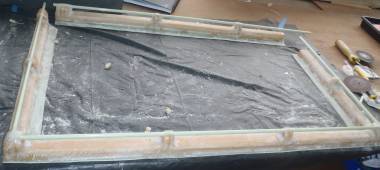 Houa's tie-down rails to go around the battery area |
We had another team removing the paint from our mast. We've been wondering if we should paint the mast (and boom) at all, or just leave them as natural aluminum. Many masts are just plain aluminum and they look just fine. The problem with paint is that moisture can get trapped under the paint, leading to corrosion and bubbling of the paint, which we had a fair amount of. The jury is still out here...
We also had a team of workers in the fo'c's'ls, grinding the paint off the ceiling on each side so they could lay strips of fiberglass reinforcing up there. This is really a bit of overkill, as the hull‑deck joint there is pretty strong. But we did affect the hull‑deck joint somewhat - part of what held it together was a series of thick rivets that went through the deck and were held on top by a thick strip of aluminum. We removed the aluminum but left the rivets. We also laid several strips of biaxial glass over the joint on the outside, but apparently Golf wants to glass over the inside of the joint‑line as well. OK...
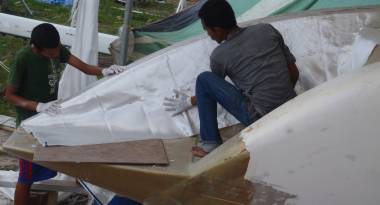 Beng and Baw laying a second skin of glass on the port wall |
Wednesday, May 9:
Another beautiful clear day with lots of workers!
We arrived this morning to find that Baw had (unexpectedly) stayed late last night and put a layer of biaxial glass on the port wall down to the extension! So now the foam is safe from rain, which tends to blow onto that corner in these SW monsoon times, despite our tent. Baw's team put another layer of glass on that wall this morning, but called it quits at 2 layers for the time being. There's a fairly significant hollow in the outside of the wall, in that it doesn't follow the shape of the hull very well. This needs to be filled, and then Baw will put on an additional 2 layers of glass.
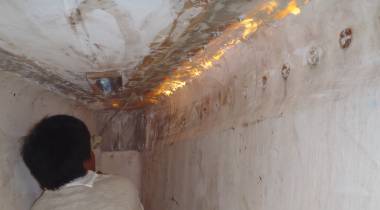 Kao, our joker, reinforcing the hull/deck joint in the fo'c's'l |
Our mechanic, Hem, was there early and decided to remove the head from our recalcitrant port engine. Hem seems convinced that there's something wrong with the valves. Jon told him again that the engine had been running fine, and that the valves shouldn't have changed. When Hem removed the head it was pretty obvious that cylinder #1 had not been firing correctly. Jon suspects that there's something wrong with that injector, but it's better to let craftsmen like Hem to fix these things their own way.
Golf showed up a bit late this morning as he was out buying some much needed supplies. When he did appear, he brought several sheets of foam as well as several gallons of epoxy. The guys fell on these like a pack of ravenous wolves.
Up forward, a team was again working in the fo'c's'ls, laying strips of glass on the areas that they'd ground back yesterday. We painted the fo'c's'ls many years ago, but the paint never cured properly and has never looked very good. So Golf offered to remove the existing paint and spray the fo'c's'ls with a layer of gelcoat. So this afternoon one of the workers was inside starboard fo'c's'l, sanding back the paint.
Max showed up a bit late, as their baby boy is expected any day. He temporarily abandoned his project in front of the salon and today worked on the rear cockpit seat. The foam on top of the backrest has been sitting there, naked and exposed, for much too long. Today that foam was trimmed back to the correct size and the aft‑facing wall of the seat was prepared for foam. By late afternoon, Max had trimmed a sheet of foam down to size and rigged up some elaborate braces to hold it against the existing fiberglass. Golf always likes to put a sheet of glass down under the foam, so Max put a skin of biaxial glass down first, then smeared on a thick layer of epoxy mud, and finally squooshed the sheet of foam into the mud and braced it for the night.
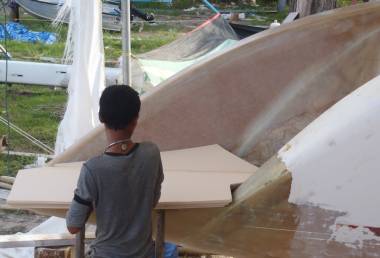 Baw fitting sheets of foam to raise the floor of port swim platform |
Houa did show up, but apparently he'd had a long night before, and he was in no fit state to work. We told Golf that we're a bit concerned that Houa is a carpenter yet he's been having to work with foam and fiberglass instead of wood. Now that we have some more fiberglass guys on the team (like Pla) Golf is planning to let Houa get back to his (many) woodworking projects, probably next week.
We also talked to Golf about the height of the transom extensions/swim platforms. We're not exactly sure where the water level will be, but we suspect it will be quite close to those platforms. They could even be awash when we sail, which might make them a bit slimier than we want. Golf suggested building them up 2‑3 inches with foam, which sounded good to us. So Baw cut some foam sheets and started fitting them to the floors of the extensions.
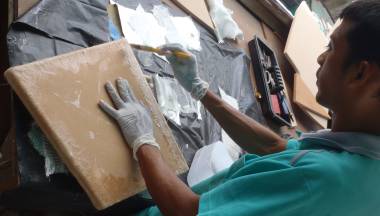 Max glassing his cute little hatch for our new compartments |
We also mentioned that it would be good to get Ocelot level, so we could know exactly where the water‑level will be. Ever since Manoon took Ocelot off her trailer, we've been a bit nose down as well as listing a bit to port - only a couple of inches, but it affects our measurements. We've lost the mark that the water made on our antifouling paint, of course, but we do still have the old boot‑stripe, which seems to be embedded into the hull a bit. We're hoping that this is symmetric on both hulls (a huge assumption, it turns out) and that it will provide us with a good reference line. Golf agreed to talk to Manoon about getting Ocelot leveled up.
Thursday, May 10:
Another good day, with clear skies and 9 workers, although school started today so we had some
minor disruptions. Baw got in a few hours of work in the morning, raising the new stern
extension floors by epoxying pieces of foam together. But he was off all afternoon, settling
his young daughter into her first day at school.
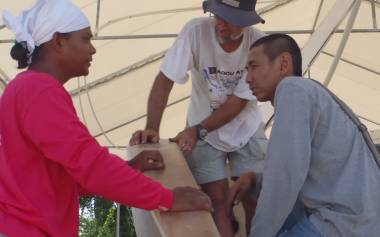 Houa & Jon talk to the Luck man about the transom hand-rails |
The big news is that our machine‑shop of choice, Luck Engineering, sent one of their stainless steel guys to talk to us about the additional jobs that we want done (they're already doing our rudders and sinks). Most of these additional jobs will be done with 1" (25mm) 316L stainless steel tubing.
First we talked about the swim ladders we want hung off the back. These will be incorporated into the stainless steel caps for the ends of our transoms. The ladders will fit into grooves in our swim platforms when they're up, giving us a (mostly) level floor back there. But they will be able to swing up and over the back to hang straight down. The rungs will be 1' (30cm) apart with the 1" (25mm) tubes flattened a bit and roughed up to be easier on the feet. Since we're still raising the floor of the swim platforms, we couldn't give Luck the final dimensions, but they got enough to start the ladders.
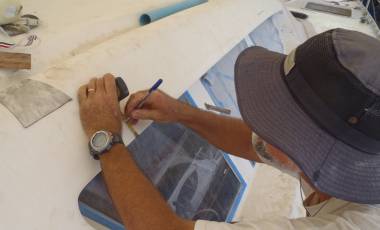 Jon measuring & plotting where the grab-rails will go |
The other projects are much less complicated, like the hand‑rails going up the walls to the swim platforms. We've already created hard‑points where we can screw these rails into the tops of the walls. These should be fairly straight forward, but the rails will curve in 2 directions, so final fitting will have to be done on Ocelot.
Another stainless steel project is grab‑rails along the sides of our main cabin. Our old grab‑rail was a strip of teak that was recessed into the top of the salon roof, but teak weathers and the railing was too far away to grab easily. More importantly, the drains at the ends of each recess leaked water into the balsa coring at the front of the salon, requiring us to rip it all out and replace it with foam. So we'll fill that recess with foam and glass it over so the cabin‑top will be smooth. Our new (stainless steel) rail will come out of the side of the main cabin, so should be much easier to grab when we have to go forward in rough conditions. The interesting part is that Jon designed exactly where the bolts should go and even drilled test holes, while the guys from Luck were there. There's a thin strip along the tops of our side windows that is not cored - it's just solid glass so it's ideal to bolt through. So the grab‑rail will go 2" (5cm) above the windows on each side.
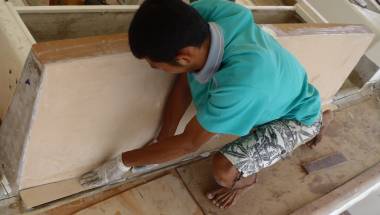 Max squooshing his strip of foam into the epoxy mud |
Finally, the backrest for the aft cockpit seat really isn't strong enough with only 3 supports, so we want Luck to put in 2 additional supports.
Back on the aft‑deck, Max and Lek put down another strip of foam, just at the base of the one they put down yesterday. This should be the final piece of foam back here. This area holds our huge Fortress storm anchor on custom chocks. Where those chocks screw down has already had the foam removed, and Lek was filling those holes with fiberglass and epoxy mud. Once Max finished laying the foam, he glassed the hatch he's been making for our new compartments up on the foredeck. He also glassed 3 sheets of foam that will form a floor for a storage area under the rear cockpit seat, where our scuba gear and spare ropes go. We've had Starboard down there, a high density polyethylene, but it's very heavy. The foam and fiberglass panels will be much lighter and much stronger.
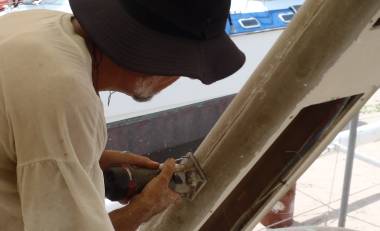 Jon routing the gelcoat out of the joint line of the Targa bar |
Pla (whose nickname means "Fish" by the way!) was working on the targa bar, preparing to glass the outside of the joint‑line that runs all along the leading edge of the targa bar. To remove the gelcoat from the joint‑line, Jon borrowed Houa's router and used it to cut a groove down the joint‑line, removing the gelcoat and preparing the groove for the epoxy mud that will go in the groove, under the strips of biaxial glass. Pla took over from Jon, finished the forward side of the bar, then attacked the old gelcoat with the grinder to ready the area to be glassed. Hopefully, the glassing phase will happen tomorrow.
Up forward, Kao, our joker, was down in the fo'c's'ls, sanding all the surfaces while Golf's big extractor fan sucked out the grindings and sucked in some good air. An ugly job, but the starboard fo'c's'l should be ready for Golf to spray on the gelcoat by tomorrow!
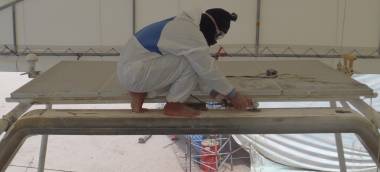 Pla grinding the top of the targa bar, with the solar panels raised |
The guys stripping the paint off the mast have almost finished. We're wondering if we should repaint it or just leave it as polished aluminum. The problem with paint is that if any moisture gets under the paint, it can start a corrosion process that bubbles the paint and looks bad. Unpainted masts rarely have this problem, and they still look quite nice. Probably a third of the masts we see are unpainted (although they may be anodized).
Friday, May 11:
We had a fair number of workers, but Pla spent much of the afternoon grinding the gelcoat off our
targa bar, making life on board difficult and the tiny bits of fiberglass were in the air
everywhere. Max was with his wife at the hospital all day, and we're expecting news of their
new arrival Real Soon Now...
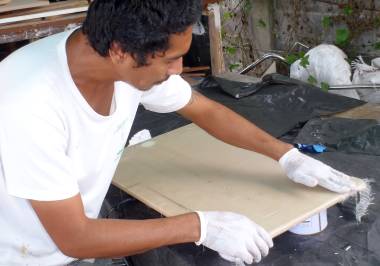 Golf glassing one of the foam panels for under the cockpit seat |
Our interesting work was actually some internet research, where Sue found that one of the new high‑tech "ropes" might be appropriate for our diamond stays. Briefly, the 8 diamond stays on our mast are solid rod‑rigging, and can only be replaced from Australia, at horrible cost. But Dyneema Dux is actually stronger than steel(!) and so light that it floats. The main issue seems to be that it can "creep" (get slowly longer) with time. It's not cheap, but it's not that expensive either, and we can easily splice thimbles into the ends ourselves, and bring it back from the US in our luggage. If there are any rigger‑types reading this, we'd appreciate your input.
If we replace our diamond stays we need to know how long they have to be, so we got out our long steel tape and replaced some of our spreaders and measured exactly how long the replacement stays have to be. Yikes! 230' (70m) total.
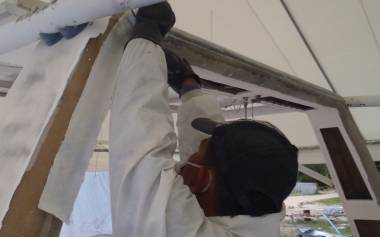 Pla glassing the joint-line on the front of Ocelot's targa bar |
Houa managed to get his wall and rail for the battery area epoxied down, but there was too much ground fiberglass in the air for him to finish the job with some fiberglass. Hopefully tomorrow...
Pla spent the morning working on the front of the targa bar. Yesterday he removed the gelcoat from the joint‑line, and this morning he filled the joint‑line with epoxy mud and then put 2 strips of biaxial glass over the joint. This should stop the cracks that we'd noticed in the gelcoat at the corners from when the targa bar flexes a bit under loads from the mainsail.
In the afternoon, Pla wanted to grind the rest of the gelcoat off, but the solar panels are still attached to the back of the targa bar. So Jon unbolted the aluminum bar that the solar panels are mounted on and raised the whole solar array enough for Pla to get his grinder in. We're hoping this job can get finished relatively quickly, as we'd like to remount the solar panels before we leave for the US at the end of the month.
Kao was sanding the paint off the inside of port fo'c's'l, but when we went in there to check his progress, we noticed that the wood was mostly just plywood covered in gelcoat, which has allowed water into the plywood and softened it. So we gave Houa the go‑ahead to rip it out and replace the plywood. We originally thought we could get away with just replacing it with more plywood, but those fo'c's'ls get a fair amount of moisture (our washing machine lives in the port fo'c's'l). To do it right, it needs to be glass covered foam. <sigh> This also gives us a chance to ask Houa to make us a good shelf for the washer.
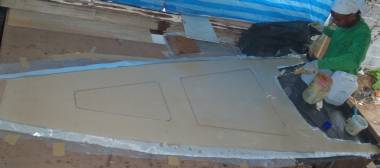 Houa glassing the big foam panel for the fo'c's'l |
Our new floors for the storage area under the rear cockpit seat are almost ready. Golf was putting a final layer of glass around the edges to seal them up. Then they need to be sanded, gelcoated, and have their finger‑holes drilled out.
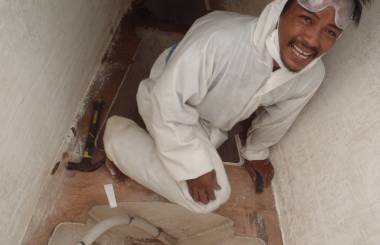 Kao, removing the wood from the port fo'c's'l |
With Max and Baw (2 of our main men) gone a lot of this week the big jobs of the raising the extension floor and foaming/glassing the foredeck are on hold. At least a lot of small jobs are happening. But we are hoping to have all the big glassing jobs done before May 30 when we fly.
Saturday, May 12:
A good day, with several advances and only a bit of rain - a shower in the morning, a sprinkle at
lunchtime, and a good rain late in the afternoon after the guys had mostly cleaned up. But
none of it really slowed us down.
The big advance today was with the port fo'c's'le (defined as: th' c'b'n f'rth'st
f'rw'rd). ![]() Late
yesterday we gave Golf the go‑ahead to rip out the old plywood and replace it with foam. Today
Houa made a template of what was needed and then used that template to cut out a sheet of foam to
(hopefully) the exact size, carefully cutting out the access panels so the cut foam could be used for
the doors. He even got a layer of biaxial glass on one side before the day was done.
Late
yesterday we gave Golf the go‑ahead to rip out the old plywood and replace it with foam. Today
Houa made a template of what was needed and then used that template to cut out a sheet of foam to
(hopefully) the exact size, carefully cutting out the access panels so the cut foam could be used for
the doors. He even got a layer of biaxial glass on one side before the day was done.
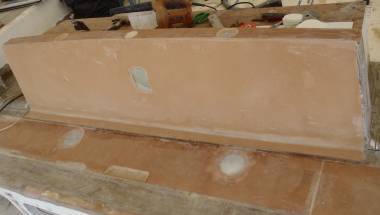 Back of our cockpit seat, with it's many cutouts in the foam |
Kao was in the port fo'c's'l all day, cutting the fiberglass with a grinder and ripping out the old plywood, a horrid job. Luckily, it looks like the vertical sheets of plywood that form the framing members in the bottom of the fo'c's'le seem fine, so we don't need to rip them out, just make sure they're well sealed with fiberglass and epoxy.
Max was working on foaming the area in front of the salon, but on port side this time. He cut out a sheet of foam and glassed one side so it will remain flexible. On Monday he'll cut slots in the foam so it will bend, allowing him to form it to the existing fiberglass.
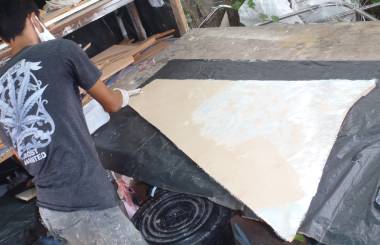 Max glassing a foam panel for the foredeck |
Pla was still working on the targa bar, grinding off the gelcoat. Luckily there was a pretty stiff breeze blowing, so the grindings were blown off the starboard quarter, where there was nobody working, luckily. He opened up and filled another joint‑line at the back of the targa bar with epoxy mud but didn't get a chance to glass it over.
Jon plotted out the locations of more places where bolts will go through the foam, requiring that the foam be removed: 3 on top of the cockpit seat for the backrest to bolt through, 1 in the back of the cockpit seat for the targa bar tensioner (that caused all the problem in the first place) and 3 on the aft deck where the supports for our storm anchor go. Once these areas had the foam removed, Lek cut a large fist‑full of small fiberglass patches and started filling the holes up. We'd have been happy with just epoxy mud, but Golf wants the strength of glass for these bolts. OK...
Our new worker, Mee (which means Bear in Thai) has taken over Houa's battery compartment project.
Today he added some glass and epoxy mud to the rail that is going around the batteries, but still
needs to glass the inside. So much work has gone into that rail that we feel we're going to
have to include it in future tours of Ocelot . ("And here's our battery compartment."
"Wow, look at that fabulous tie‑down rail for the
batteries!" "Yeah, what craftsmanship!" "It's a work of art all by
itself!" ![]() )
OK, back to reality...
)
OK, back to reality...
Jon also got to spend some time removing the old water‑mixing/control valves from the bathrooms. Three down, one to go. The new ones (from the US) aren't the same size or shape as the old French fittings, so we'll have to do something creative with cover‑plates to hide the old mounting holes, but Golf assures us this will be no problem.
Thai Refit:
Ocelot Pages:
Top Level: Home | Destinations | Cruising Info | Underwater | Boat Guests | Ocelot | Sue | Jon | Amanda | Chris | Site Map | Make a Comment
|
If our information is useful, you can help by making a donation |
Copyright © 2000‑ Contact: Jon and Sue Hacking -- HackingFamily.com, svOcelot.com. All rights reserved.